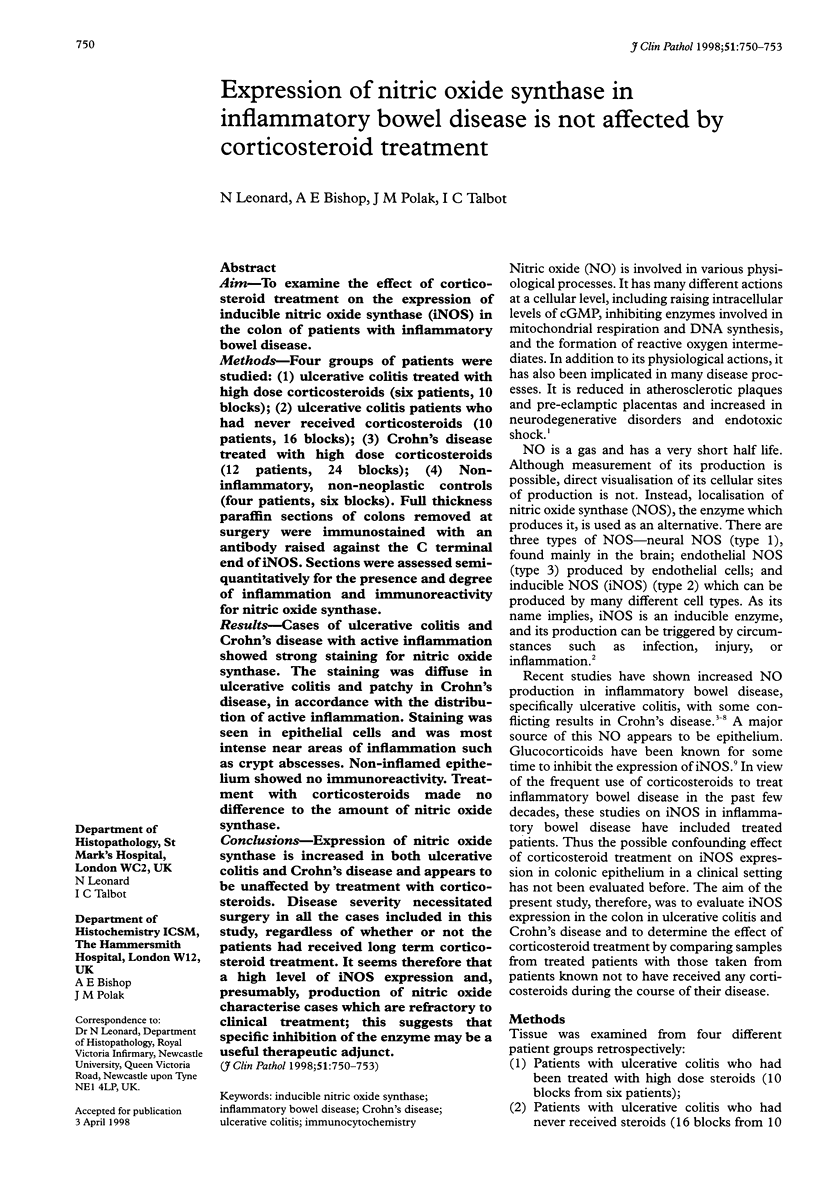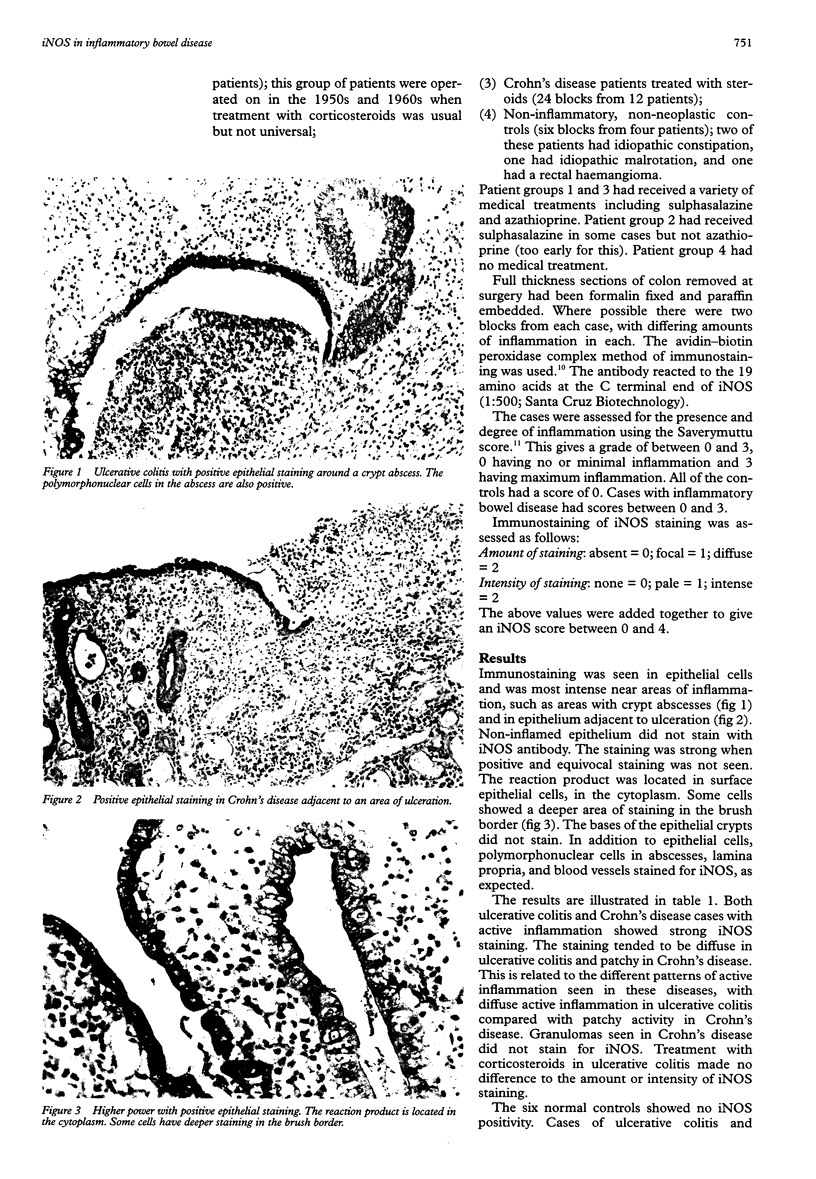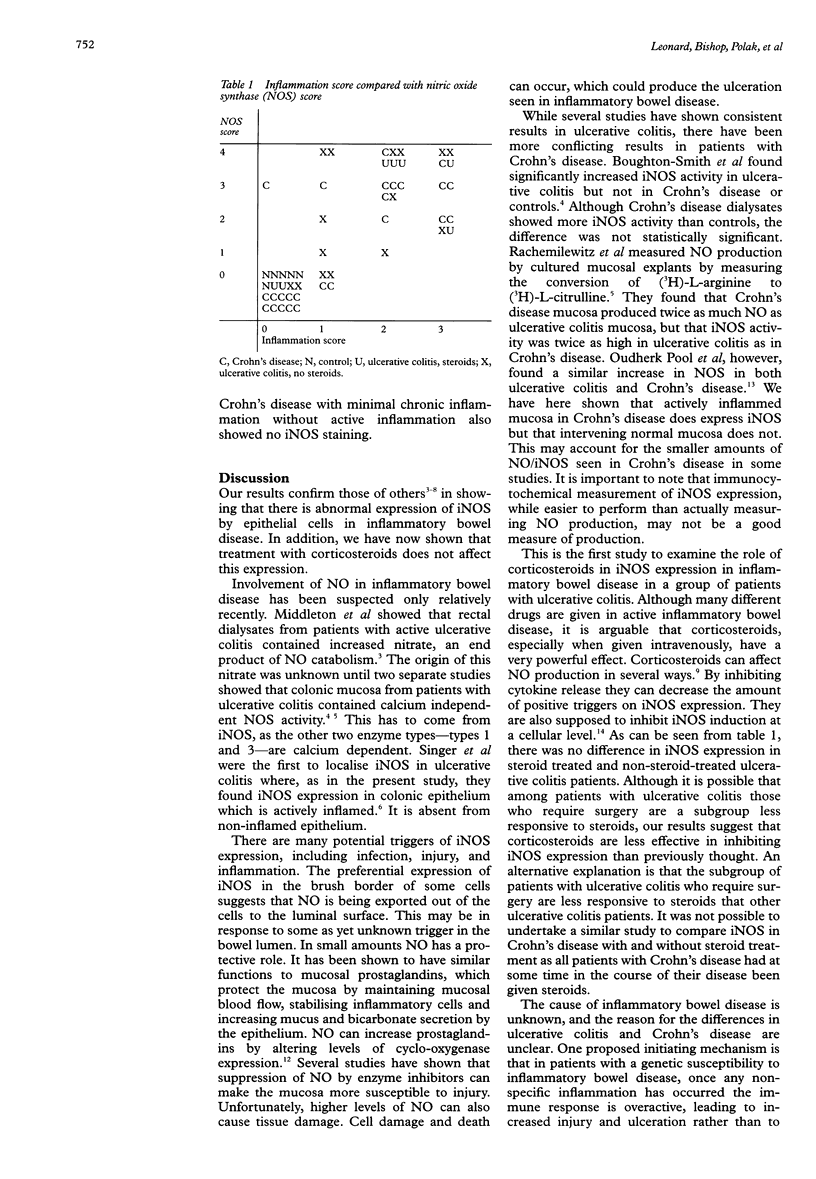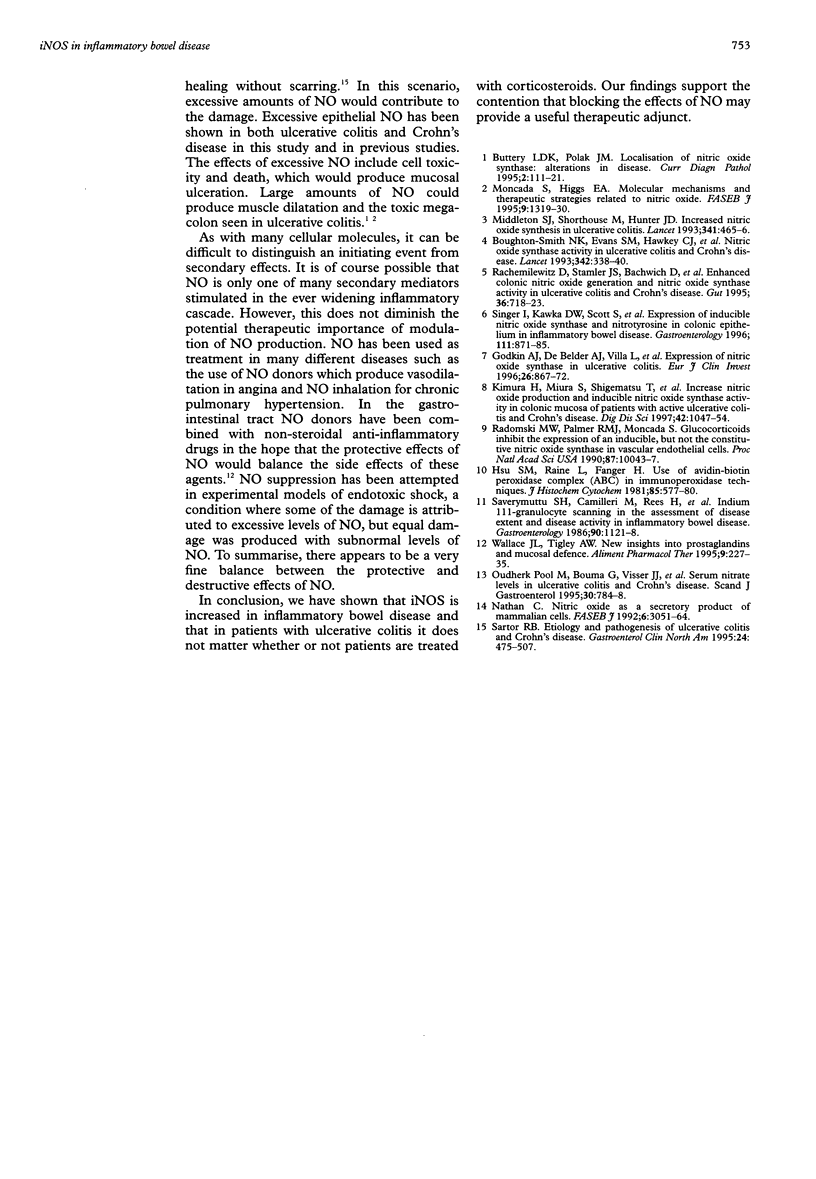Abstract
AIM: To examine the effect of corticosteroid treatment on the expression of inducible nitric oxide synthase (iNOS) in the colon of patients with inflammatory bowel disease. METHODS: Four groups of patients were studied: (1) ulcerative colitis treated with high dose corticosteroids (six patients, 10 blocks); (2) ulcerative colitis patients who had never received corticosteroids (10 patients, 16 blocks); (3) Crohn's disease treated with high dose corticosteroids (12 patients, 24 blocks); (4) Non-inflammatory, non-neoplastic controls (four patients, six blocks). Full thickness paraffin sections of colons removed at surgery were immunostained with an antibody raised against the C terminal end of iNOS. Sections were assessed semiquantitatively for the presence and degree of inflammation and immunoreactivity for nitric oxide synthase. RESULTS: Cases of ulcerative colitis and Crohn's disease with active inflammation showed strong staining for nitric oxide synthase. The staining was diffuse in ulcerative colitis and patchy in Crohn's disease, in accordance with the distribution of active inflammation. Staining was seen in epithelial cells and was most intense near areas of inflammation such as crypt abscesses. Non-inflamed epithelium showed no immunoreactivity. Treatment with corticosteroids made no difference to the amount of nitric oxide synthase. CONCLUSIONS: Expression of nitric oxide synthase is increased in both ulcerative colitis and Crohn's disease and appears to be unaffected by treatment with corticosteroids. Disease severity necessitated surgery in all the cases included in this study, regardless of whether or not the patients had received long term corticosteroid treatment. It seems therefore that a high level of iNOS expression and, presumably, production of nitric oxide characterise cases which are refractory to clinical treatment; this suggests that specific inhibition of the enzyme may be a useful therapeutic adjunct.
Full text
PDF



Images in this article
Selected References
These references are in PubMed. This may not be the complete list of references from this article.
- Boughton-Smith N. K., Evans S. M., Hawkey C. J., Cole A. T., Balsitis M., Whittle B. J., Moncada S. Nitric oxide synthase activity in ulcerative colitis and Crohn's disease. Lancet. 1993 Aug 7;342(8867):338–340. doi: 10.1016/0140-6736(93)91476-3. [DOI] [PubMed] [Google Scholar]
- Godkin A. J., De Belder A. J., Villa L., Wong A., Beesley J. E., Kane S. P., Martin J. F. Expression of nitric oxide synthase in ulcerative colitis. Eur J Clin Invest. 1996 Oct;26(10):867–872. doi: 10.1111/j.1365-2362.1996.tb02131.x. [DOI] [PubMed] [Google Scholar]
- Hsu S. M., Raine L., Fanger H. Use of avidin-biotin-peroxidase complex (ABC) in immunoperoxidase techniques: a comparison between ABC and unlabeled antibody (PAP) procedures. J Histochem Cytochem. 1981 Apr;29(4):577–580. doi: 10.1177/29.4.6166661. [DOI] [PubMed] [Google Scholar]
- Kimura H., Miura S., Shigematsu T., Ohkubo N., Tsuzuki Y., Kurose I., Higuchi H., Akiba Y., Hokari R., Hirokawa M. Increased nitric oxide production and inducible nitric oxide synthase activity in colonic mucosa of patients with active ulcerative colitis and Crohn's disease. Dig Dis Sci. 1997 May;42(5):1047–1054. doi: 10.1023/a:1018849405922. [DOI] [PubMed] [Google Scholar]
- Middleton S. J., Shorthouse M., Hunter J. O. Increased nitric oxide synthesis in ulcerative colitis. Lancet. 1993 Feb 20;341(8843):465–466. doi: 10.1016/0140-6736(93)90211-x. [DOI] [PubMed] [Google Scholar]
- Moncada S., Higgs E. A. Molecular mechanisms and therapeutic strategies related to nitric oxide. FASEB J. 1995 Oct;9(13):1319–1330. [PubMed] [Google Scholar]
- Nathan C. Nitric oxide as a secretory product of mammalian cells. FASEB J. 1992 Sep;6(12):3051–3064. [PubMed] [Google Scholar]
- Oudkerk Pool M., Bouma G., Visser J. J., Kolkman J. J., Tran D. D., Meuwissen S. G., Peña A. S. Serum nitrate levels in ulcerative colitis and Crohn's disease. Scand J Gastroenterol. 1995 Aug;30(8):784–788. doi: 10.3109/00365529509096328. [DOI] [PubMed] [Google Scholar]
- Rachmilewitz D., Stamler J. S., Bachwich D., Karmeli F., Ackerman Z., Podolsky D. K. Enhanced colonic nitric oxide generation and nitric oxide synthase activity in ulcerative colitis and Crohn's disease. Gut. 1995 May;36(5):718–723. doi: 10.1136/gut.36.5.718. [DOI] [PMC free article] [PubMed] [Google Scholar]
- Radomski M. W., Palmer R. M., Moncada S. Glucocorticoids inhibit the expression of an inducible, but not the constitutive, nitric oxide synthase in vascular endothelial cells. Proc Natl Acad Sci U S A. 1990 Dec;87(24):10043–10047. doi: 10.1073/pnas.87.24.10043. [DOI] [PMC free article] [PubMed] [Google Scholar]
- Sartor R. B. Current concepts of the etiology and pathogenesis of ulcerative colitis and Crohn's disease. Gastroenterol Clin North Am. 1995 Sep;24(3):475–507. [PubMed] [Google Scholar]
- Saverymuttu S. H., Camilleri M., Rees H., Lavender J. P., Hodgson H. J., Chadwick V. S. Indium 111-granulocyte scanning in the assessment of disease extent and disease activity in inflammatory bowel disease. A comparison with colonoscopy, histology, and fecal indium 111-granulocyte excretion. Gastroenterology. 1986 May;90(5 Pt 1):1121–1128. doi: 10.1016/0016-5085(86)90376-8. [DOI] [PubMed] [Google Scholar]
- Singer I. I., Kawka D. W., Scott S., Weidner J. R., Mumford R. A., Riehl T. E., Stenson W. F. Expression of inducible nitric oxide synthase and nitrotyrosine in colonic epithelium in inflammatory bowel disease. Gastroenterology. 1996 Oct;111(4):871–885. doi: 10.1016/s0016-5085(96)70055-0. [DOI] [PubMed] [Google Scholar]
- Wallace J. L., Tigley A. W. Review article: new insights into prostaglandins and mucosal defence. Aliment Pharmacol Ther. 1995 Jun;9(3):227–235. doi: 10.1111/j.1365-2036.1995.tb00377.x. [DOI] [PubMed] [Google Scholar]





